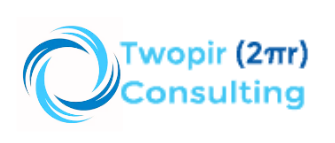Donorbox – Simplifying Fundraising for Nonprofits
Donorbox is a popular online fundraising software that helps nonprofit organizations and charities collect donations on their websites. It offers customizable donation forms that are easy to embed on websites, making it simple for donors to contribute. Donorbox supports various payment methods, including credit/debit cards, ACH bank transfers, and PayPal. Additionally, it provides features such as recurring donations, donor management tools, and integrations with other platforms like Salesforce and Mailchimp. Overall, Donorbox aims to streamline the donation process for nonprofits and improve their fundraising efforts.
Here are some common problems that Donorbox can help solve :
Limited Online Presence: Nonprofits may struggle to establish a strong online presence for accepting donations, especially if they lack the technical expertise to set up online donation forms. Donorbox provides customizable donation forms that are easy to embed on websites, enabling nonprofits to collect donations securely and efficiently online.
- Difficulty in Collecting Donations: Nonprofits may encounter challenges in collecting donations from supporters, mainly if the donation process is complex or cumbersome. Donorbox simplifies the donation process with its user-friendly interface and support for multiple payment methods, making it easier for donors to contribute.
- Inconsistent Revenue Streams: Nonprofits often face the challenge of maintaining consistent revenue streams to support their programs and initiatives. Donorbox’s recurring donation feature allows nonprofits to establish a reliable stream of income by enabling donors to set up regular, ongoing contributions.
- Lack of Donor Management Tools: Nonprofits may struggle to effectively manage donor information and communication without dedicated donor management tools. Donorbox offers features for tracking donor activity, storing donor contact details, and segmenting donor lists for targeted outreach and engagement efforts.
- Data Security Concerns: Nonprofits must prioritize the security and privacy of donor data to maintain trust and compliance with regulations. Donorbox prioritizes security and compliance with industry standards, such as PCI DSS, to protect donor information and ensure secure payment processing.
- Limited Insight into Donor Behavior: Nonprofits may lack insight into donor behavior and preferences, making it challenging to optimize fundraising strategies and campaigns. Donorbox provides reporting and analytics features that enable nonprofits to track donation performance, analyze trends, and generate insights to enhance their fundraising efforts.
- Integration Challenges: Nonprofits may struggle to integrate fundraising tools with other platforms and systems used for donor management, communication, and analytics. Donorbox offers integrations with third-party platforms such as Salesforce, Mailchimp, and Google Analytics, streamlining fundraising efforts and enhancing donor engagement.
- Budget Constraints: Nonprofits often operate with limited budgets and resources, making it essential to choose cost-effective fundraising solutions. Donorbox offers transparent and affordable pricing plans tailored to the needs of nonprofit organizations, with no setup fees and flexible pricing based on factors such as donation volume and additional features.
Here are some problem-solving techniques and how they can be applied within Donorbox:
- Identify Key Challenges: The first step in problem-solving is to identify the key challenges faced by the nonprofit in its fundraising efforts. This could include issues such as low donation conversion rates, limited donor engagement, or difficulties in managing donor data.
- Set Clear Objectives: Once the challenges are identified, nonprofits should set clear objectives for addressing them using Donorbox. For example, the objective could be to increase donation conversion rates, improve donor retention, or streamline donor management processes.
- Utilize Customization Features: Donorbox offers various customization features that can be leveraged to address specific challenges. Nonprofits can customize donation forms to improve donor engagement, create targeted fundraising campaigns to increase donation conversion rates and personalize thank-you messages to enhance donor retention.
- Implement Best Practices: Nonprofits can use Donorbox’s reporting and analytics features to identify best practices and trends in their fundraising efforts. By analyzing donation data, nonprofits can identify what strategies are working well and implement them more broadly to address challenges.
- Leverage Integration Options: Donorbox integrates with third-party platforms such as Salesforce, Mailchimp, and Google Analytics, providing nonprofits with additional tools and resources to address fundraising challenges. Nonprofits can use these integrations to improve donor communication, track campaign performance, and gain insights into donor behavior.
- Experiment and Iterate: Donorbox enables nonprofits to experiment with different fundraising strategies and iterate based on feedback and results. Nonprofits can A/B test donation forms, try out different messaging and imagery, and adjust their fundraising approach based on what resonates most with donors.
- LSeek Support Resources: Donorbox offers customer support and resources to help nonprofits address fundraising challenges. Nonprofits can reach out to Donorbox support for assistance, access help documentation and tutorials, and participate in webinars to learn best practices and tips for using the platform effectively.
- Measure and Monitor Progress: Nonprofits should regularly measure and monitor their progress in addressing fundraising challenges using Donorbox. By tracking key metrics such as donation conversion rates, donor retention rates, and campaign performance, nonprofits can assess the effectiveness of their efforts and make adjustments as needed.
Some key features and aspects of Donorbox:
- Customizable Donation Forms: Donorbox provides customizable donation forms that nonprofits can easily embed on their websites. These forms can be tailored to match the branding and design of the organization’s website, creating a seamless donor experience.
- Multiple Payment Options: Donorbox supports various payment methods, including credit/debit cards, ACH bank transfers, and PayPal. This flexibility allows donors to contribute using their preferred payment method.
- Recurring Donations: Nonprofits can enable recurring donation options through Donorbox, allowing donors to set up regular, ongoing contributions. This feature is beneficial for sustaining support and maintaining a predictable income stream.
- Donor Management Tools: Donorbox offers tools for managing donor information and communication. Nonprofits can track donor activity, send thank-you messages, and segment their donor base for targeted outreach.
- Security and Compliance: Donorbox prioritizes security and compliance with industry standards, such as PCI DSS (Payment Card Industry Data Security Standard). This ensures that donor data is protected and transactions are secure.
- Integrations: Donorbox integrates with various third-party platforms and tools commonly used by nonprofits, such as Salesforce, Mailchimp, and Google Analytics. These integrations help organizations streamline their fundraising efforts and leverage data for better insights.
- Reporting and Analytics: Nonprofits can access reporting and analytics features within Donorbox to track donation performance, analyze trends, and gain insights into donor behavior. This data can inform fundraising strategies and decision-making.
- Affordability: Donorbox offers pricing plans tailored to the needs of nonprofit organizations, with transparent pricing and no setup fees. The platform typically operates on a subscription basis, with pricing based on factors such as donation volume and additional features.
Steps for Donorbox Integration with Salesforce :
Step1:- Sign Up for Salesforce for Nonprofits
Just follow these steps to sign up for Salesforce for Nonprofits. If you’re already using Nonprofit Success Pack or Nonprofit Cloud, skip to the next step.
- Choose whether your organization wishes to use NPSP or Nonprofit Cloud.
- If you want you can Sign up for a 30-day free trial. You can do that for NPSP here or for Nonprofit Cloud here.
- Check your email for a confirmation email from support@salesforce.com. Confirm your account by setting a new password.
Step2:- Connect Donorbox and Salesforce
- To begin the data integration, you first need to connect Donorbox with your Salesforce account. You can access this add-on from your Donorbox dashboard in the “Available Add-Ons” section, or in the menu on the left side of your screen under “Integrations and Add-ons.” Click on either to be taken to the Salesforce Integration page.
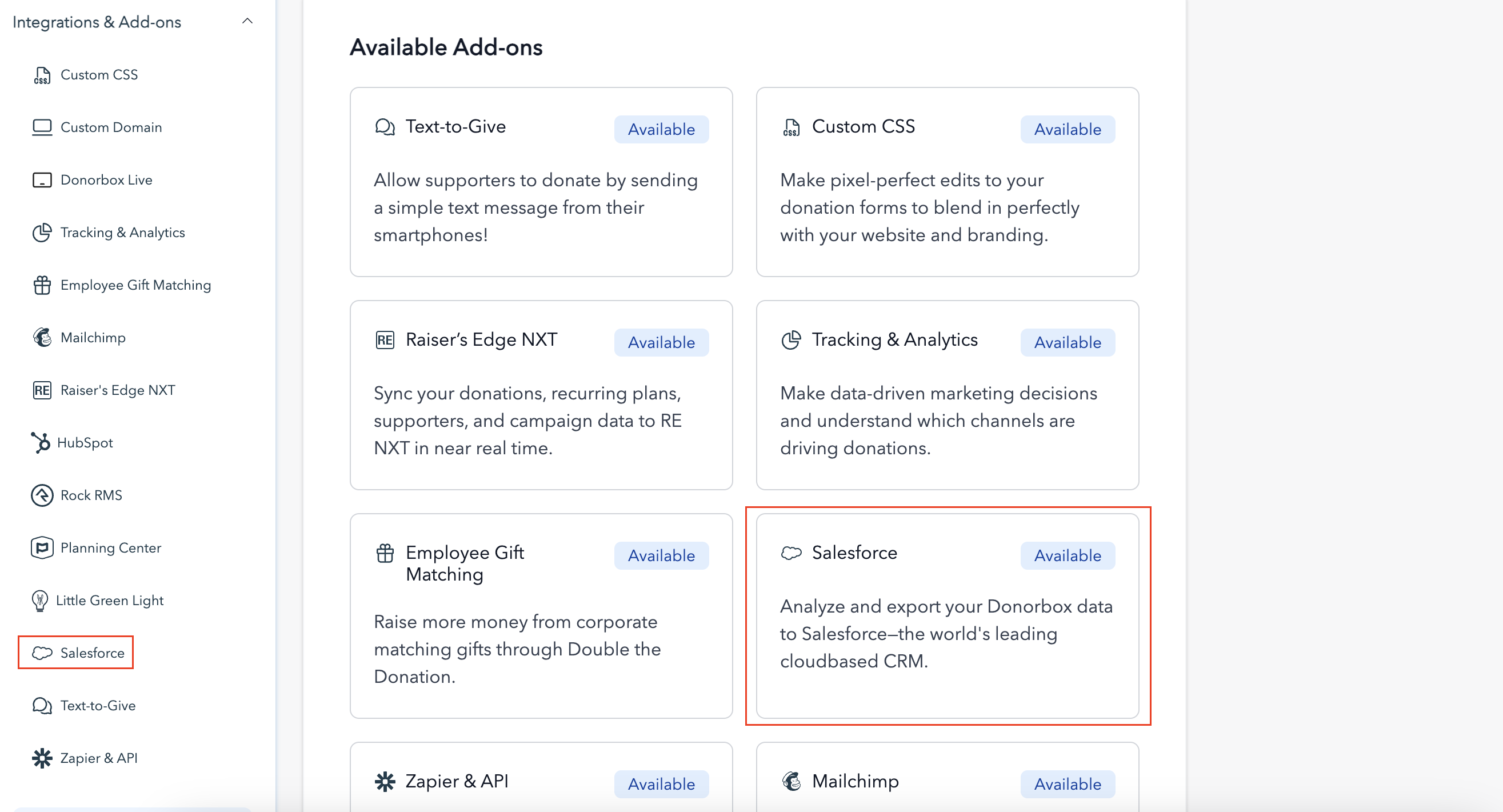
From the integration page, you’ll see toggle options for Production Mode and Sandbox Mode.
Production Mode is for connecting to your live Salesforce org with active users and data. Sandbox Mode allows you to connect to your Salesforce Sandbox org without disturbing your Production org.Choose which mode you’d like to enable and click the toggle to activate it.
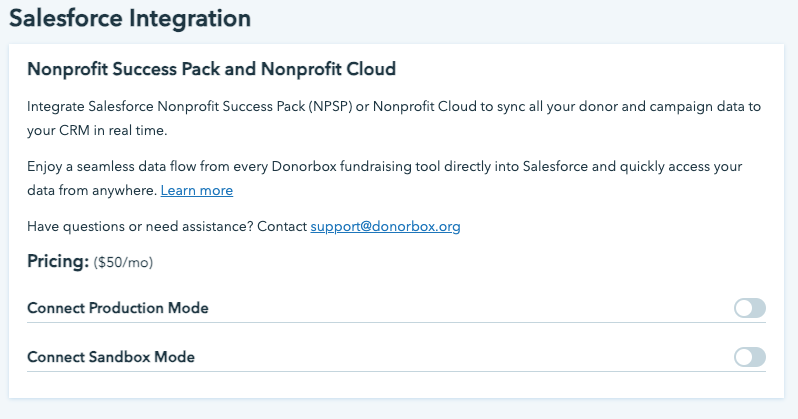
Once you click on one of the toggles, you’ll be prompted to sign in to your Salesforce account.
Note: be sure to log in with a user account that has sufficient permissions, like an admin account.You’ll be prompted to enter a verification code with multi-factor authentication. Once verified, you’ll be asked to allow access to Donorbox. Click “Allow.”

After a successful connection, you will be redirected to the Salesforce Integration page in your Donorbox Account. It should now look like this:

Step3:- Map Donorbox Data to Salesforce Objects
After your integration is set up, your data will automatically flow to your Salesforce account. There may be some additional field mapping you wish to do to customize your integration further. Check the below steps to learn how.
Standard Fields :
For any standard fields on your Donorbox form (i.e. anything other than additional questions you add), you may customize how they map to objects in your Salesforce org.
- On your Salesforce Integration page, you will find the “Salesforce Fields” section.
- You’ll see a list of all Donorbox data fields, along with dropdowns for the corresponding Salesforce fields available to you. Connect each Donorbox field to your preferred Salesforce field.
Note: Check out our detailed Data Mapping guide for more information on field mapping between Donorbox and Salesforce.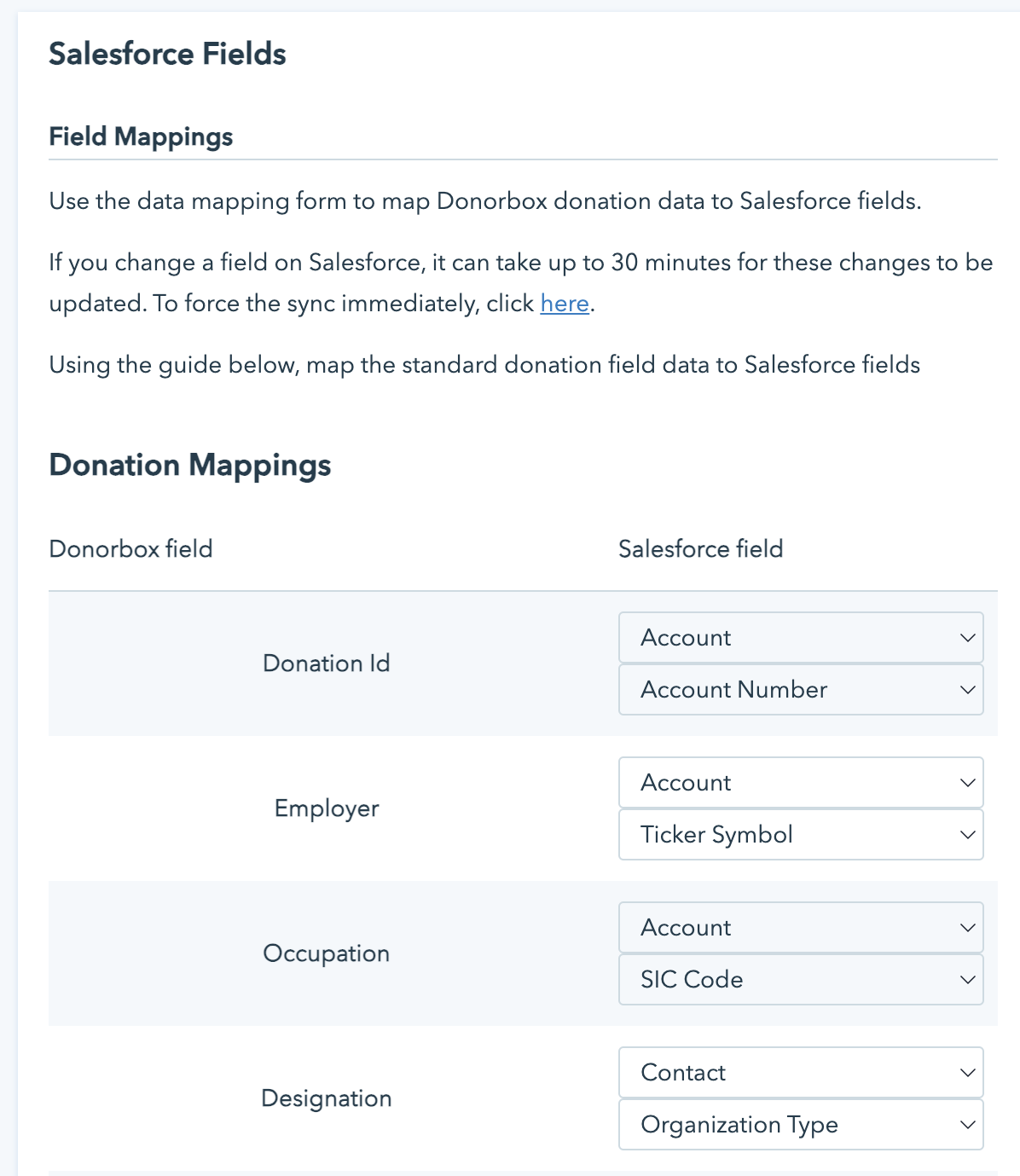
Custom Fields :
If you ask your donors additional questions on your Donorbox donation form, you may want to record their answers in Salesforce. You can do this with Custom Fields.
- Head back to your Salesforce Integration page
- Next to the data mapping section, you’ll see the “Campaign Specific Mappings” section. Here, you can map a Donorbox campaign to a Salesforce campaign. First, click the edit icon next to the Donorbox campaign name.

You’ll then be taken to a settings page where you can select the Salesforce campaign that corresponds to your selected Donorbox campaign.
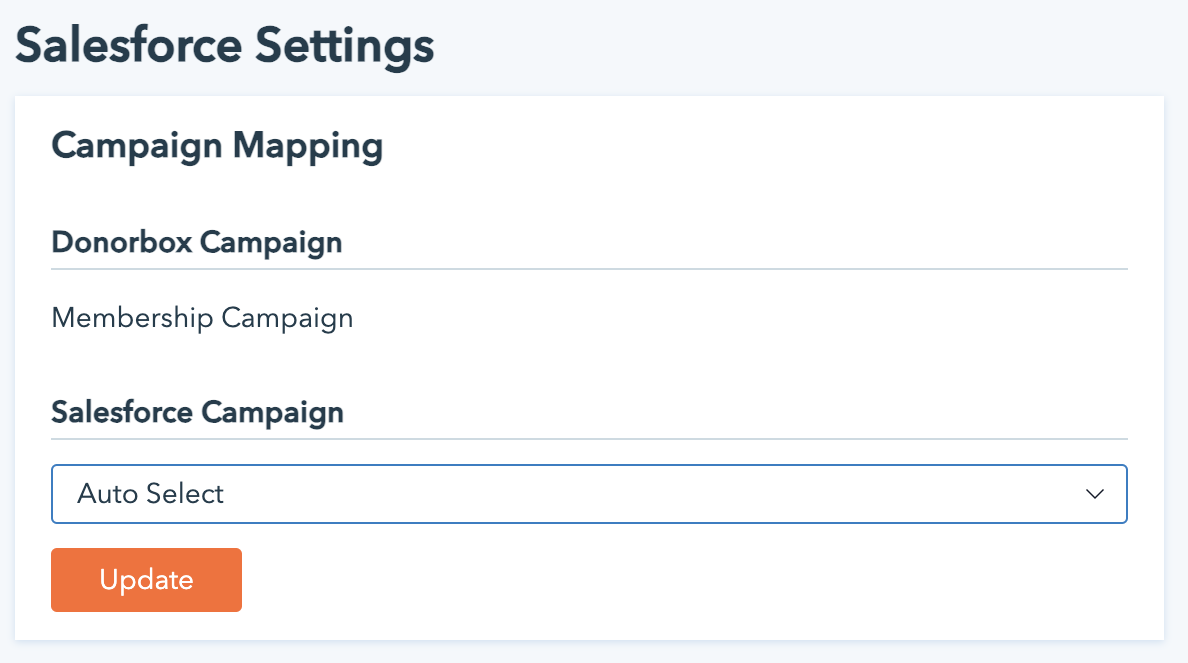
Just like the standard field mapping above, you can map the values of additional questions to standard or custom fields in your Salesforce objects. Note: this option will only appear if you have added additional questions to your donation form.
Step 4: Syncing Donorbox With Salesforce
Export Donorbox Data :
Now that you have all your fields mapped, you are ready to export your donors, campaigns, and donations data to your Salesforce org.
Simply go to your Salesforce Integration page and click on the “Unexported Donations” button in the Export Data section. Note that moving forward, all donor and campaign data will be automatically exported shortly after each donation.

Here, you can enable any events you create with Donorbox Events to sync with Salesforce as well. You can also view your Failure Log to check for any mapping or exportation failures.
Re-Export Donations :
We all need a re-do sometimes. The “All Donations” button in the Export Data section deletes the existing donations from your Salesforce org and exports them again from your Donorbox account.
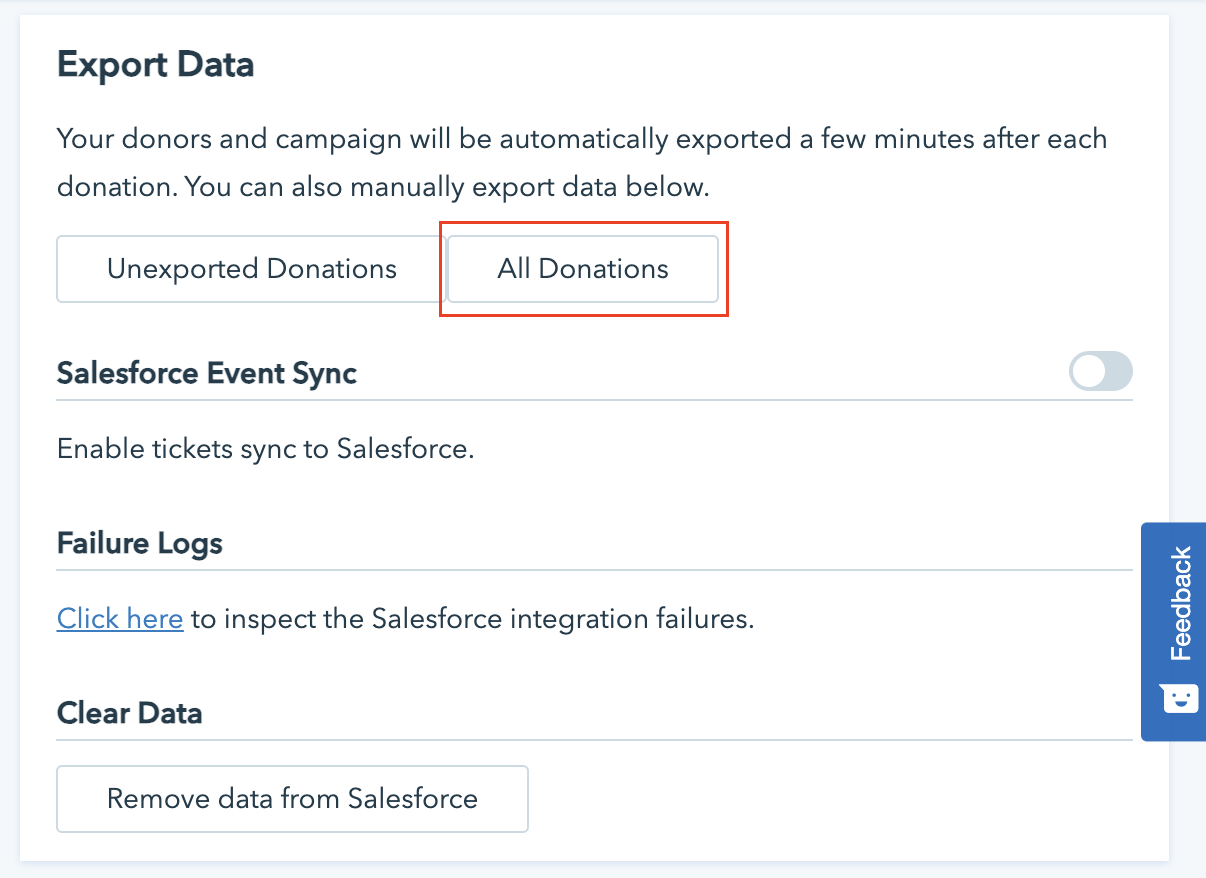
It’s important to note that this functionality does not remove and re-create the Accounts (Households) and Contacts from your Salesforce org.
Remove Data :
The “Remove data from Salesforce” button removes all the donations (Opportunity records in Salesforce) that have been made by Donorbox.
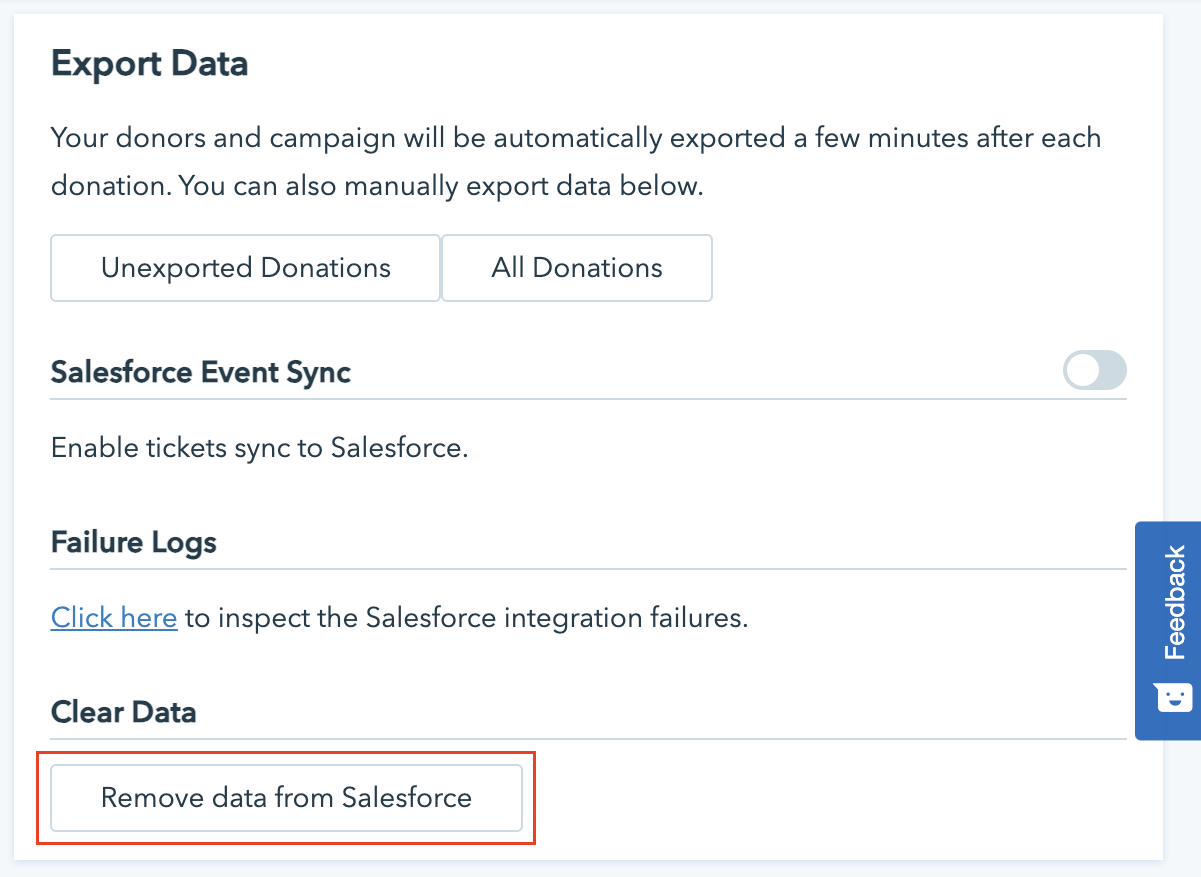
Note: It does not remove the Accounts and Contacts that were created with the donations. This is because these Accounts and Contacts may now be linked to other records in Salesforce too. You can always delete them from within Salesforce if you don’t need them.
Donations in Salesforce :
When a donation is made to your Donorbox campaign, it is automatically exported to your Salesforce org. It gets mapped to an Opportunity record in your Salesforce org.
With the donation, the corresponding Contact, Account, and Campaign are also created in Salesforce.
The Campaign name is the same as your Donorbox campaign name.
The primary contact name is an amalgamation of the donor’s first name and last name, as given on your donation form.
The Account (Household) name follows the Salesforce NPSP naming convention that you have selected in your NPSP household naming format if you are using the NPSP package. If you are using the Nonprofit Cloud then the integration will create a Person account.
Conclusion :
In conclusion, Donorbox stands as a powerful ally for nonprofit organizations and charities seeking to enhance their fundraising efforts. With its intuitive interface, robust customization options, and emphasis on security and compliance, Donorbox offers a comprehensive solution for collecting donations online.
For assistance with Salesforce and Donorbox, please contact us directly by completing the form below.
Contact Us
We would love to hear from you
Please feel free to send us a message via the form
